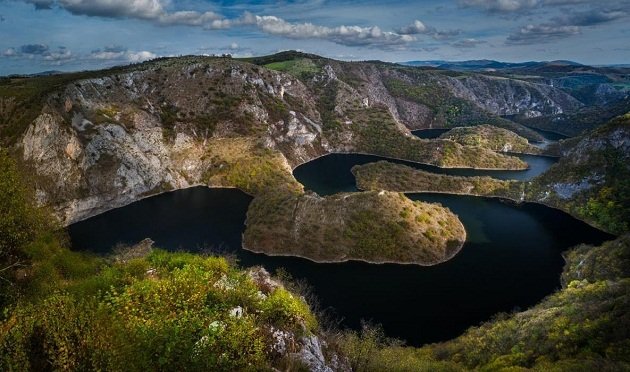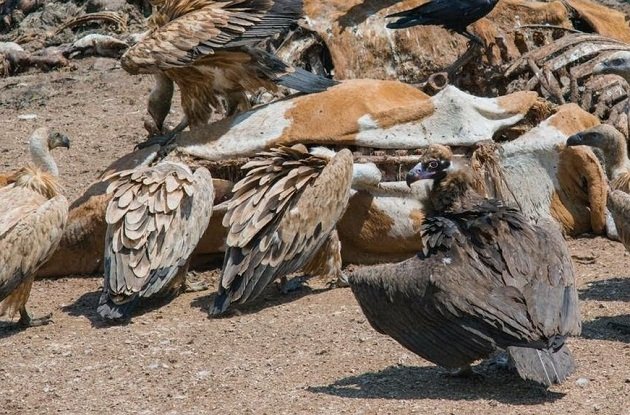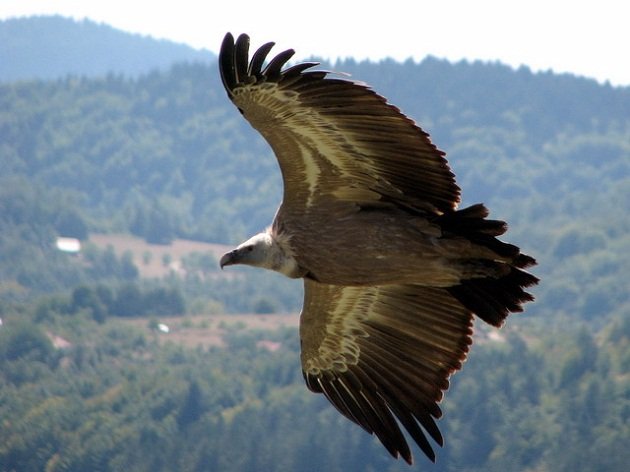
Early morning finds me driving southeast through spruce forests, mountain meadows, pastures and an occasional potato field, across Mt. Zlatar in western Serbia, heading towards the town of Sjenica and, behind it, the bridge on the River Vapa. As we go lower, from glorious sunshine, we enter the morning fog. Are we going to bird in the fog?
Still, we are lucky. At about 900 metres / 3000 ft a.s.l., the Sjenicka Plateau (where the Vapa meanders) is below the clouds. En route we pass a White Stork’s nest with a chick on the electricity pylon, plus Bullfinch and Northern Wheatears at the roadside.
This is my first visit to this area, known as the Madz Brod, where two new breeding species for the country were discovered a decade ago. The first of them I spot as soon as I park: five Fieldfares are foraging in the short grass by the river. They are common winter visitors, but this is my first observation of them in the breeding season.
Several Whinchat and Eurasian Skylark territories around, a Common Raven’s nest on a high voltage pylon, one Northern Lapwing in flight, a bush-top Red-backed Shrike, and singing Marsh Warbler in riverside vegetation. But I cannot notice the breeder #2!
My friend Puza comes back from a short walk… and shows me the photos of the more elusive #2: the not-so-common Common Rosefinch, a female. It is somewhere in those willows.
I am checking the crown-tops, there is a Common Whitethroat… but I can hear the Rosefinch. Scanning carefully, small birds occasionally fly from one tree to the other, but I cannot discover them in the foliage! I have observed it previously in India, but never in Europe… but will have to settle with a voice and no sight. Still, it’s a new bird for my country list.
Back to the Uvac Dam where a large group of conference participants is leaving the shuttle bus as I stop the car… While I am carefully reversing through the scattered bunch, a lucky few saw the main prize landing at the hilltop vulture restaurant: the huge Cinereous Vulture (or Eurasian Black Vulture)! Alas, I am not among them.
 Cinereous Vulture and Eurasian Griffons at Uvac vulture restaurant (c) Sasa Preradovic
Cinereous Vulture and Eurasian Griffons at Uvac vulture restaurant (c) Sasa Preradovic
We entered the “quadrimaran” (actually, two catamarans tied side by side) and started a tour of a submerged gorge (by the dam, depth of the lake reaches about 100 metres / 330 ft). Eurasian Griffon Vultures are flying towards the restaurant (occasionally visited by Brown Bear, too). At first I was counting the vultures, but later, as more and more groups were flying away from the restaurant while the others were still flying there, I gave up the count when I reached 110 and estimated that I have seen more than 150 of them. Last winter, 310 Griffons were counted in this reserve – making it by far the largest colony in mainland Balkans.
Two female Eurasian Goosanders are fleeing in front of the vessel. It is still early and their young are in the nests, at the cliff ledges, but later in the season the lake will be full of females followed by trains of chicks.
The gorge meanders ever deeper, limestone cliffs rising ever higher and Griffons flying really close. At some rock faces we see juveniles on their nesting ledges. The adult Griffons are used to humans and are not stressed by the visitors, but some nests are really low – the lowest being a mere 5 metres above water and chicks sometimes get scared enough to fall into the lake. Operated by the reserve warden Marko Obucina, whose late father Borko was the first voluntary warden here even before the reserve was officially proclaimed, our quadrimaran would stop and turn back before that particular nest. But, recreational boating is allowed and unguided anglers and kayakers are often unaware of the risk they may pose.
 Eurasian Griffon (c) Brano Rudic
Eurasian Griffon (c) Brano Rudic
Later in the hotel, Puza and I asked for an early dinner, so we could run away to chase some sunset birds (umm, English is not my first language, but I am under the impression that this may have some other meaning). We chose a large opening in the spruce forest, so we could see the tree-tops against the sky, open beers and wait. Close by, movement on the ground – a Yellowhammer, but immediately behind it, almost half-hidden by it, like in those educational posters where various birds are bunched next to each other, a Red-backed Shrike, male, unusually – on the ground.
We wait some more time without success and chose to move a bit further along the road. Now it is a smaller clearing and less of a chance to spot our target – the Eurasian Woodcock. Quarter of a century ago, these birds were believed to breed only in the north of Europe, in Fennoscandia and Russia, and just migrate through these areas. But Puza – Slobodan Puzovic – thought otherwise and turned his discovery of the Balkan breeding population of Woodcocks into his master thesis.
We wait again. Temperature drops to 11oC. The last birds singing in the darkness are Coal Tits, Song Thrushes and the European Robin. My mobile phone rings, I drop my eyes from the sky, Puza yells “There it is!” but everything is over too quickly and before I manage to see it, the Woodcock disappears. Bloody phone! BTW, have I mentioned that I have never seen a Woodcock?!
Now I keep my eyes glued to the sky above the trees. The night is already falling and it may be too late. But let’s wait a bit longer. And a bit more. I am underdressed and getting cold. There!!
Straight towards us (so that its long beak becomes invisible), rolling in flight from one flank to other, not unlike some Flying Fox, one male Eurasian Woodcock is displaying (“roding”) in flight. And I am sure that I was much more impressed by his display than any woodhen might be, if there were any at all.
Cover photo: Uvac Gorge (c) Sasa Preradovic














Leave a Comment